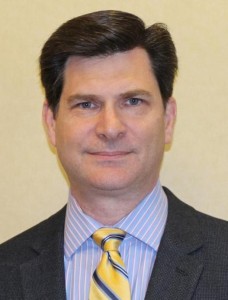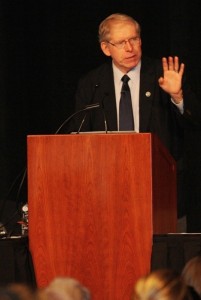The most powerful message in patient engagement comes down to a single word: “empowerment.”
Last week more than 500 people convened for the “Better Health: Everyone’s Responsibility,” a full-day educational event at the Connecticut Convention Center in Hartford, hosted by the CT Partners for Health.
The conference was aimed at empowering consumers to proactively manage their health and engage in the health care system. It also targeted physicians and other providers to educate them on how to more effectively communicate with their patients.
CT Partners for Health was founded by Qualidigm, a non-profit health care consulting firm and one of the state-based
Quality Improvement Organizations across the U.S. I sat down with Tim Elwell, Qualidigm’s President & CEO, to talk about the event.
This event was widely considered to be one of the first of its kind in Connecticut. What was the impetus to hold this conference?
The CT Partners for Health is a working group of stakeholders who identify health care related issues that present challenges to the consumer and provider community in Connecticut. After months of meeting, we decided to do a project together. We chose to focus on patient engagement since that was a common theme among stakeholders as an area where we needed improvement and education for Connecticut.
Everyone’s talking about patient engagement. What was the buzz at the Better Health conference?
The buzz was utter amazement. Almost everyone who attended said they had never been to anything like this before. We had breakout sessions on issues like medication management, patient-centered care, advance care planning, communication between providers and patients, and emerging technologies for consumers to manage their health. With medication management, we addressed how providers can be talking to their patients so they can always stay in compliance. There was a lot of enlightenment from consumers and providers in the audience. A physician we often work with came up to me after a technology session and said he couldn’t wait to share what he learned with his patients.
Do patients and caregivers define patient engagement differently? Did you find that they have different expectations?
We were bringing to the forefront the fact that patient engagement is something that is lacking in health care.
Our keynote speaker, “e-Patient Dave” deBronkart, is fond of saying the most under-utilized resource in health care is the patient. We wanted to be able to empower consumers more and get providers to understand how important this is. This event allowed us to create a level setting for both providers and consumers.
A lot of people have been advocating for more involvement by patients in their own care, but it’s a two-way street: Caregivers have a key role to play as well. How did that come across at the conference?
This was the first time that, as a group, we were talking to a combined consumer/provider market. When it comes down to it, though, when we break it down by consumer and provider we realize that everyone is a consumer of health care. Providers were able to see themselves in the role of the patient and were able to learn some valuable lessons to give to their patients and use for themselves. We spent some time discussing motivational interviewing along the lines of shared decision making — making patients (and their caregivers) know they can be part of their health care goals. Patients can help come up with a solution that works for them. We also discussed the importance of advanced directives and how poorly, as a state, Connecticut was doing in this area.
The name of the conference, “Better Health: Everyone’s Responsibility,” implies a strong correlation between health and accountability.
We had a brainstorming session and were throwing around names, but ultimately came back to our goal as a grassroots entity — what do we want for our family, friends and co-workers? We want better health. There is a lot of representation from providers on the CT Partners for Health and we realized we cannot always put the onus on the providers. It’s critical for consumers to be involved and engaged. So the title was a little more self-reflective — the “better health” part is what we all want, but it is not on the shoulders of just one person, one entity or one organization. According to the United Health Foundation’s 2012 edition of America’s Health Rankings, Connecticut placed sixth in the ranking of the U.S.’ healthiest states. As a state, we have a lot of potential and I don’t think there is any reason we can’t become number one. Qualidigm and the CT Partners for Health are committed to supporting this effort, but one company can’t do it alone. Everyone has to jump on board. Everyone is responsible for making Connecticut a better, healthier state.
What were the key lessons attendees walked away with?
People took away tangible “how-to’s” from the conference. We had audience members saying, “Now, I know I can get access to my medical records, so I will ask for my files and review the notes from my health care provider.” It was a sense of empowerment and the audience walked away truly learning what options are available to better manage their health and effectively engage in the health care delivery system.
What surprised you most about the conference?
Two things. The first was how engaged people were and how much they valued the information they learned. We had an extremely captive audience! One attendee, a compliance officer, said this was the first conference where she didn’t check emails on her phone all day — it was that compelling. The other surprise was how many non-medical staff or administrators attended — we had 60 people walk in off the street! We worked hard to make it super affordable — just $10 and free parking.
What are the next steps? What actions do you hope and expect attendees to take?
We see last week’s Better Health conference as the first day of a statewide initiative to improve patient engagement in Connecticut. We are now approaching the state Department of Public Health, the Governor’s office and state legislature to rally even more support. We are working with a researcher from the American Institute for Research, who sought us out, and wanted to be part of it. Her study found there is significant value in having patients involved in their care. “E-Patient Dave” deBronkart is also eager to work with Connecticut on developing this statewide action plan. As we were waiting for the day to begin, and just before I introduced Dave, he leaned over to me and said, “I’ve never seen anything like this. This really is patient engagement.” Coming from Dave, who’s been all around the United States, I realized we were onto something.
You got some great media on this event. Does it surprise you, given where health care is today, that patient engagement and patient advocacy are such big topics?
In a way, because when we first discussed developing this conference last year, patient engagement did not immediately rise to the top of the list. All of a sudden the issue was popping up everywhere. In fact, the February 2013 issue of Health Affairs was devoted to the topic and highlighted the value and importance of patient engagement. The Centers for Medicare & Medicaid also launched initiatives geared towards families and patient engagement. It is now top of mind for everyone — and we want to continue that. And it makes dollars and sense! That Health Affairs article indicated that an engaged patient costs 8 to 21 percent less than a patient who is not engaged! That’s significant.
Will we see a sequel next year?
Absolutely! We intend to host future educational forums on patient engagement and we are considering doing a “road show” around the state so more people have access to this type of information. We want to make sure we are getting to every single consumer and health care provider to help improve patient outcomes and make Connecticut a better, healthier state.







